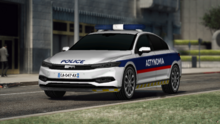Law enforcement in Romaia
This article is incomplete because it is pending further input from participants, or it is a work-in-progress by one author. Please comment on this article's talk page to share your input, comments and questions. Note: To contribute to this article, you may need to seek help from the author(s) of this page. |
Law enforcement in Romaia is centralized on a national level, carried out by multiple national forces, helped by few limited local agencies. The Romaian law enforcement system is considered complex, with multiple police forces and other agencies taking part in different duties. Policing in the Romaian system refers to the duties of "full-powered officers" coming from the three national main forces: National Police, National Gendarmerie and Customs . While the duties of these three corps' include investigating arresting, other local forces carry out limited duties.
The two main police forces in the country are the Chorofylaki, the national gendarmerie, as well as the Ethniki Astynomia, the civil national police. The third one is the Teloneio, a police force responsible for dealing with financial crime, smuggling, illegal drug trade, and others. The main forces are managed and organized on a departmental level under the authority of the Chef in accordance with the provincial representative of the Government.
Border and Maritime patrolling are undertaken by the Customs and Gendarmerie. The Penitentionary Administration is the national prison police agency, controlling penitentiaries and inmate transfers. Although policing in Romaia is primarily provided on a national basis, there also exists municipal police.
Law enforcement in Romaia is an exclusive function of the State and is organized under the Ministry of the Interior, with provincial division and jurisdiction. The highest office in charge of law enforcement is the ministerial office of State Direction of the Public Security. The Chorofylaki, are also Military Police for the Romaian Armed Forces, in charge of investigation or intervention inside Public Administrations and personal rights violations. There is also a Honour Guard regiment. Chorofylaki stations are usually distributed all over the country, with a station approximately in every municipality (or at least every 5 km), with additional stations in strategical positions along the motorways.
In 2019, the total number of active police officers in all of the agencies was about 300 thousands in Romaia, one of the highest in Eulabia per capita.
Structure
National police forces
National police

The National Police is the civil national police of Romaia. Along with patrolling, investigative and law enforcement duties, it patrols motorways, and oversees the security of railways, bridges, and waterways.
It is a civilian police force, while the Chorofylaki is military. While its internal organization and mindset are somewhat military, its personnel is composed of civilians. Its headquarters are in Constantinoupoli, and there are Regional and Departamental divisions throughout Romaia.
National gendarmerie
The Chorofylaki is the common name for the Ethniki Chorofylaki, a gendarmerie-like military corps with police duties. They also serve as the military police for the Romaian Armed Forces and can be called upon for national defence action.
The Chorofylaki have become a separate armed force (alongside the Army, Navy and the Air Force), thus ending their long-standing tradition as the First Corps of the Romaian Army.
Having both military police duties and civil police duties, the Chorofylaki is usually called on duty as riot police during big events and demonstrations.
Customs
The Customs (Greek: Τελωνείο) is a Romaian law enforcement agency under the authority of the Minister of Economy and Finance. It is a police force, forming a part of the Ministry of Economy and Finance. Customs are essentially responsible for dealing with financial crime and smuggling; it has also evolved into Romaia's primary agency for suppressing the illegal drug trade.
Interforces
Other agencies
National level
- Security Service
- Maritime Gendarmerie
- Penitentionary administration
Local level
- Municipal polices including public roads surveillance
- Coast protection services
- Wolfcatchers
Police and gendarmerie
The leadership of both agencies is centralized and they both have conventional deviance control responsibilities respectively except in different geographical locations. The National Police is responsible for urban areas whereas the gendarmerie is responsible for small towns and rural areas with fewer than 20,000 inhabitants.
A redistribution of authority was thus decided and implemented between 2003 and 2005. Large conurbations are now handled entirely by the police. Rural and suburban areas, and some smaller cities with populations ranging from 5,000 to 16,000, are handled by the gendarmerie.
In addition, the police and the gendarmerie have specific zones of authority:
The police handle questions about the admittance, monitoring and continuing stay of foreigners (border police); The gendarmerie handle all matters regarding the military, the police at sea, the security of airports, and the security of certain public buildings.
Police jurisdictions
Summary table
| Corps | Dependance | Public officer | Public security agent | Public security officer | Judiciary police agent | Judiciary police officer | Tribunal police agent | Tribunal police officer | Military police | |
|---|---|---|---|---|---|---|---|---|---|---|
| Romaian Armed Forces | Ministry of Defence | X (military) | ||||||||
| Corps of military order | National Gendarmerie | Ministry of Defence | X | X | X | X | X | X | ||
| Corps of civil order | National Police | Ministry of the Interior | X | X | X | X | X | |||
| Customs | Ministry of Economy and Finances | X | X | X | X | X | X | |||
| Penitentiary Administration | Ministry of Justice | X | X | X | X | |||||
| National Firefighters Corps | Ministry of Interior | X | X | X | X | |||||
| Corps of local enforcement | Comunal Police | Comune of affiliation | X | X | X | X | X |
